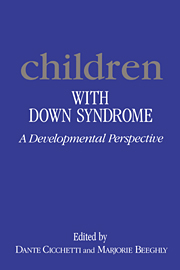Book contents
- Frontmatter
- Contents
- List of contributors
- Preface
- 1 Applying the developmental perspective to individuals with Down syndrome
- 2 An organizational approach to the study of Down syndrome: contributions to an integrative theory of development
- 3 Temperament and Down syndrome
- 4 Interactions between parents and their infants with Down syndrome
- 5 Attention, memory, and perception in infants with Down syndrome: a review and commentary
- 6 Sensorimotor development of infants with Down syndrome
- 7 The growth of self-monitoring among young children with Down syndrome
- 8 Early conceptual development of children with Down syndrome
- 9 Language abilities in children with Down syndrome: evidence for a specific syntactic delay
- 10 Beyond sensorimotor functioning: early communicative and play development of children with Down syndrome
- 11 Peer relations of children with Down syndrome
- 12 Families of children with Down syndrome: ecological contexts and characteristics
- 13 Early intervention from a developmental perspective
- Name index
- Subject index
10 - Beyond sensorimotor functioning: early communicative and play development of children with Down syndrome
Published online by Cambridge University Press: 02 November 2009
- Frontmatter
- Contents
- List of contributors
- Preface
- 1 Applying the developmental perspective to individuals with Down syndrome
- 2 An organizational approach to the study of Down syndrome: contributions to an integrative theory of development
- 3 Temperament and Down syndrome
- 4 Interactions between parents and their infants with Down syndrome
- 5 Attention, memory, and perception in infants with Down syndrome: a review and commentary
- 6 Sensorimotor development of infants with Down syndrome
- 7 The growth of self-monitoring among young children with Down syndrome
- 8 Early conceptual development of children with Down syndrome
- 9 Language abilities in children with Down syndrome: evidence for a specific syntactic delay
- 10 Beyond sensorimotor functioning: early communicative and play development of children with Down syndrome
- 11 Peer relations of children with Down syndrome
- 12 Families of children with Down syndrome: ecological contexts and characteristics
- 13 Early intervention from a developmental perspective
- Name index
- Subject index
Summary
Introduction
Although there is no doubt that the rate of language development in children with Down syndrome is delayed in relation to their chronological age, results from a plethora of studies suggest that the sequence and structure of their early language development is largely similar to that observed in normally developing children (see Fowler, Chapter 9, this volume; Miller, in press; for recent reviews). An examination of different domains within language (phonology, syntax, semantics, pragmatics) and relationships of language with cognition and social development also reveals more similarities than differences (Beeghly & Cicchetti, 1985, 1986; Beeghly, Hanrahan, Weiss, & Cicchetti, 1985; Cunningham, Glenn, Wilkinson, & Sloper, 1985; Fowler, Chapter 9, this volume; Mervis, Chapter 8, this volume; Rondal, 1988). On the basis of these studies, most investigators conclude that there is not compelling evidence for a strong “difference” or “deficit” model of language development for these children, just as for mentally retarded children in general.
Nonetheless, important differences in the language development of children with Down syndrome also have been documented that are crucial to comprehend if we are to understand the process of development in these children. Perhaps the most striking difference is the dramatic delay in expressive language development of children with Down syndrome, relative to that observed in other retarded and nonretarded groups (see Chapter 9 by Fowler and Chapter 8 by Mervis, this volume, for reviews). Despite similarities in structure and sequence for most aspects of language, results of many studies document that individuals with Down syndrome show increasing linguistic deficits with advancing chronological age (Gibson, 1978; Miller, in press). Indeed, some individuals do not progress beyond early stages of syntactic development (see Fowler, Chapter 9, this volume; but see Rondal, 1988, for exceptions).
- Type
- Chapter
- Information
- Children with Down SyndromeA Developmental Perspective, pp. 329 - 368Publisher: Cambridge University PressPrint publication year: 1990
- 50
- Cited by

